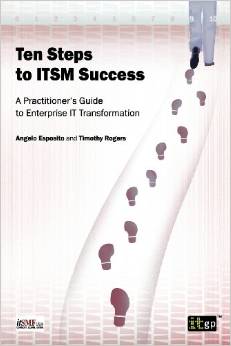If you are responsible for an ITSM Program or are about to embark on a new or revitalized ITSM journey, there is a new book you should check out. It is called Ten Steps to ITSM Success: A Practitioner’s Guide to Enterprise IT Transformation by Tim Rogers and Angelo Esposito. While I haven’t had a chance to read the book yet, Tim was kind enough to give me a run down of its core message.
What I like about it is that it focuses on the right things. I have always believed that the reason that ITSM adoption efforts tend to fail is because people think that they’re engaging in a process improvement effort. But what they’re really doing is engaging in an organizational change effort. When we focus on the process (which, by the way, is the easy part, in my opinion) we miss the part that really makes the difference – the people.
Tim and Angelo’s ten-step process is built to keep you focused on the right things – the mechanics – that you need to effectively execute this kind of organizational change. If you know me, you know that I tend to live at “50,000 feet.” I like to think about things at a philosophical and theoretical level. Personally, I believe that we don’t do enough of that in IT circles. But the challenge with that is that in order to get anything done we need to translate from the theoretical to the practical. That’s what this book does.
While it may not seem that it is focused on “people” per se, the ten steps that they lay out are all focused on laying the ground work that enables people to make a change. Steps like, Step 1: Setting the Stage/Establishing the Business Plan”, Step 4: Establish ITSM Governance and Step 5: Define the Ideal Target State (as well as the others) get folks focused on the outcomes desired and the decisions that need to be made to get there. Great stuff.
There’s a lot there and I am sure that I’m only scratching the surface, but if the intro that I received is any indicator, it will be time and money well spent. To me, this is how it nets out. ITSM is one of the greatest tools that we, as IT professionals, have to shape and transform our IT organizations into the customer-centric and value-driving organizations that we must become. I am always saddened when I see organizations make a mess of their ITSM adoption efforts because they are squandering the power of this tool. But like any tool, it’s only what you do with it that matters. If this book can help you use this tool to its full effect, it will be a very smart investment indeed.
If you’ve read the book, chime in here and let us know what you think!
About the Author:





